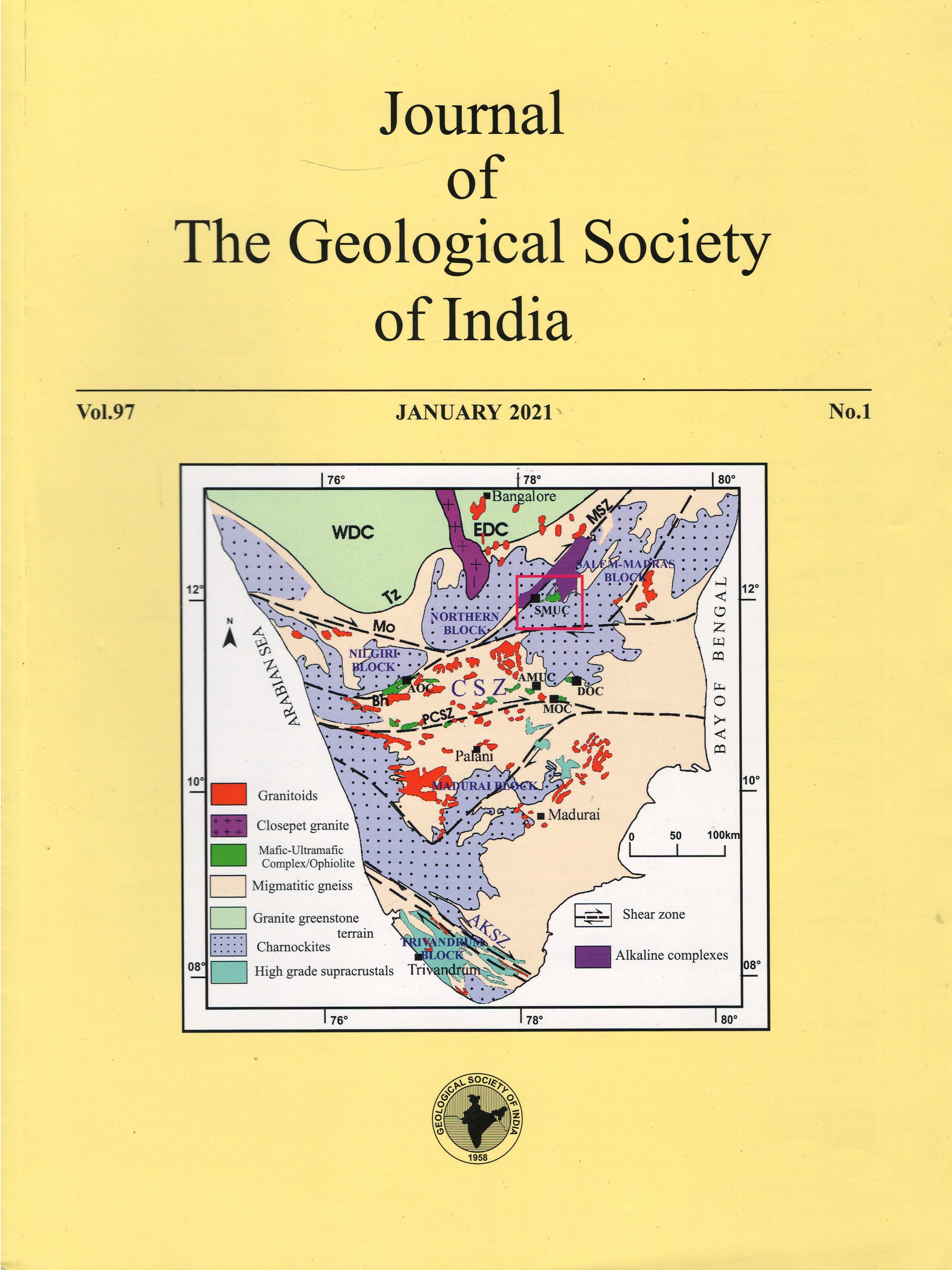<i>Hillichnus agrioensis</i> and Associated Trace Fossils from Hettangian to Bajocian Thaiat Member of Lathi Formation, Jaisalmer Basin, Western Rajasthan
DOI:
https://doi.org/10.1007/s12594-021-1625-2Keywords:
No Keywords.Abstract
The present paper describes the abundant and very well preserved ichnotaxon complex Hillichnus agrioensis, as established by four different morphological levels of exposures. Associated trace-fossils such as Jamesonichnites heinbergi and Ancorichnus ancorichnus are also being reported from the Hettangian to Bajocian Thaiat Member of Lathi Formation of Jaisalmer basin, western Rajasthan, India. The ichnospeices Hillichnus agrioensis is being documented for the first time in India. Morphologically, Hillichnus agrioensis includes straight to gently curved, branched or feather-like (almost flat) structures with a central tube. It is interpreted as a deep-burrowing bi-siphonate or tellinaceans bivalves. The ichnotaxon Jamesonichnites heinbergi is interpreted as a burrow made by an infaunal deposit-feeder (fodinichnion), while Ancorichnus ancorichnus is domichnion and may also solely be the result of locomotion (repichnion). This study suggests the presence of shallow or marginal-marine environment for the above-mentioned trace-fossil bearing horizons as trace-fossils characterized by such features have also been found from other parts of the world.
Downloads
Metrics
Issue
Section
Downloads
Published
How to Cite
References
Bromley, R.G., Uchman, A., Gregory, M.R., and Martin, A.J. (2003) Hillichnus lobosensis igen. et isp. Nov., a complex trace fossil produced by tellinacean bivalves. Paleocene, Monterey, California, USA. Palaeogeo. Palaeoclimat. Palaeoeco., v.192, pp.157-186.
Dam, G. (1990) Palaeoenvironmental significance of trace fossils from the shallow marine Lower Jurassic Neill Klinter Formation, East Greenland. Palaeogeo. Palaeoclimat. Palaeoeco., v.79, pp. 221-248.
Dasgupta, S.K. (1974) Stratigraphy of western Rajasthan shelf: Pro. IV Indian Colloq., Micropal. Strat., Dehradun, India, pp.219-233.
Dasgupta, S.K. (1975) A revision of the Mesozoic-Tertiary stratigraphy of Jaisalmer Basin, Rajasthan. Jour. Earth Sci., v.2, pp.77-94.
Desai, B.G. and Saklani, R.D. (2014) Ichnofabric analysis of the Tithonian shallow marine sediments (Bhadasar Formation) Jaisalmer Basin, India, Jour. Earth Sys. Sci., v.123(6), pp.1413-1431. DOI: 10.1007/s12040-014-0462-8.
Ekdale, E. G. and Ekdale, A.A. (2018) Hillichnus lobosensis, an unusually complex trace fossil of burrowing bivalves from the Paleogene of southern California, U.S.A. Palaeogeo. Palaeoclimat. Palaeoeco., v.493,pp.121-125.
Fürsich, F.T. and Heinberg, C. (1983) Sedimentology, biostratinomy and palaeoecology of an Upper Jurassic offshore sand bar complex. Bull. Geo. Soc. Denmark, v.31, pp.67-95.
Fürsich, F.T. (1998) Environmental distribution of trace fossils in the Jurassic of Kachchh (western India). Fazies, v.39, pp.243-272.
Hedeny, El-., Hewaidy, M.A. and Kahtany, Kh. AI., (2012) Shallow marine trace fossils from the Callovian-Oxfordian Tuwaiq Mountain imestone and Hanifa Formations, central Saudi Arabia. Australian Jour. Basic and App. Sci., v.6, pp.722-733.
Heinberg, C., (1974) A dynamic model for a meniscus filled tunnel (Ancorichnus n. ichnogen.) from the Jurassic Pecten Sandstone of Milne Land, East Greenland. Rapp. Grønl. Geol. Unders, v.62, pp.1-20.
Heinburg, C. and T. Birkelund., (1984) Trace fossil assemblages and basin evolution of the Vardekløft Formation (Middle Jurassic, central East Greenland). Jour. Paleont., v.58, pp.362-397.
Hill, G.W. (1981) Ichnocoenoses of a Paleocene submarine canyon floor, Point Lobos, California. In: Frizzell, V. (Ed.), Upper Cretaceous and Paleocene Turbidites, central California Coast: Pacific Section, Society of Economic Paleontologists and Mineralogists, Guidebook, Field Trip No.6, pp.93-104.
Keighley, D.G. and Pickerill, R.K. (1994) The ichnogenus Beaconites and its distinction from Ancorichnus and Taenidium. – Palaeontology, v.37, pp.305-337.
Lukose, N.G., Misra, C.M. (1980) Palynology of pre-Lathi (Permo-Triassic) of Shumarwali Talai structure, Jaisalmer Western Rajasthan, India: IV International Palynological Conference Lucknow, v.2, pp.219-227.
Misra, C.M., Prasad, B. and Rawat, R.S. (1996) Triassic palynostratigraphy from the subsurface of Jaisalmer Basin, Western Rajasthan. In: J. Pandey, R. J. Azmi, A. Bhandari, and A. Dave, (Eds.), Contrs. XV Indian Colloq. Micropal. Strat. KDMIPE and WIHG publication, Dehradun, pp.55-62.
Oldham, R.D., (1886) Preliminary notes on the Geology of Northern Jaisalmer. Rec. Geol. Surv. India, v.19, pp.157-160.
Pandey, D. K., Sha, J., Choudhary, S., (2006b) Depositional history of the early part of the Jurassic succession on the Rajasthan Shelf, western India. Progress in Natural Science (Special issue of IGCP 506 on the Jurassic Boundary Events) Beijing, v.16, pp.176-185.
Pandey, D.K., Choudhary, S., Bahadur, T., Swami, N., Poonia, D. and Sha, J., (2012) A review of the Lower most Upper Jurassic facies and stratigraphy of the Jaisalmer Basin, western Rajasthan, India. Volu. Jura., v.10, pp.61-82.
Pandey, D.K., Sha, J. and Choudhary, S., (2006a) Depositional environment of Bathonian sediments of the Jaisalmer Basin, Rajasthan, western India. Progress in Natural Science (Special issue of IGCP 506 on the Jurassic Boundary Events) Beijing, v.16, pp.163-175.
Pareek, H.S. (1984) Pre- Quarternary geology and mineral resources of north-western Rajasthan. Mem. Geol. Surv. India, v.115, p.99.
Parihar, V. S., Nama, S. L., Gaur, V. and Mathur, S.C. (2016) New Report of Theropod (Eubrontes glenrosensis) dinosaur footprints from the Thaiat Member of Lathi Formation of Jaisalmer Basin, Western Rajasthan, India. 4 th International Ichnological Congress Global Geopark, Portugal, pp.124-125.
Parihar, V.S., Nama, S.L. and Mathur, S.C., (2017) Discovery of Trace Fossils from Lower Odania Member of Lathi Formation of the Jaisalmer Basin, District -Jaisalmer, Western Rajasthan, India. Inter. Jour. Adv. in Ecol. and Envi. Res., v.2, pp.195-210.
Patel, S.J., Bhatt, N.Y. and Desai, B.G., (2008) Asteriacites quinquefolius – Asteroid Trace Maker from the Bhuj Formation (Lower Cretaceous) of the Mainland Kachchh Western India. Jour. Geol. Soc. India, v.71, pp.129-132.
Pazos, P.J. and Fernandez, D.E. (2010) Three-dimensionally integrated trace fossils from shallow-marine deposits in the Lower Cretaceous of the Neuquen Basin (Argentina): Hillichnus agrioensis isp. nov.: Acta Geol. Polo., v.60, pp.105-118.
Pienkowski, G., Branski, P., Pandey, D.K., Schlogl, J., Alberti, M. and Fursich, F.T., (2015) Dinosaur footprints from the Thaiat ridge and their palaeoenvironmental background, Jaisalmer Basin, Rajasthan, India. Volu. Jura., v.1 (XIII), pp.17- 26.
Roy, A.B. and Jakhar, S. R. (2002) Geology of Rajasthan (North West India) Precambrian to Recent. Scientific Publishers, (India), Jodhpur, p.421.
Singh, M.C., Kundal, P. and Kushwaha, R.A.S., (2010) Ichnology of Bhuban and Bokabil Formations, Oligocene–Miocene deposits of Manipur Western Hill, Northeast India, Jour. Geol. Soc. India, v.76, pp.573-586.

 V. S. Parihar
V. S. Parihar






